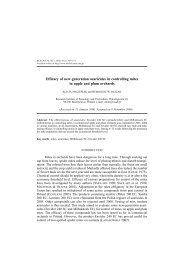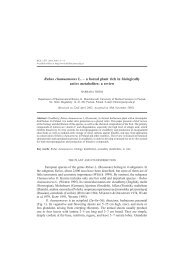The possible hybrid origin of the feather mite Avenzoaria canuti ...
The possible hybrid origin of the feather mite Avenzoaria canuti ...
The possible hybrid origin of the feather mite Avenzoaria canuti ...
You also want an ePaper? Increase the reach of your titles
YUMPU automatically turns print PDFs into web optimized ePapers that Google loves.
126 Agnieszka Badek and Jacek Dabert<br />
Fig. 7. Unrooted neighbour-joining trees for males and females. Host names are shown in paren<strong>the</strong>ses.<br />
Numbers in T. glareola designate <strong>the</strong> population locations given in Table 1.<br />
tal shield, Fig. 2). It shows also intermediate proportions <strong>of</strong> 2 character states between<br />
A. totani and A. calidridis (e.g. shape <strong>of</strong> interior tooth <strong>of</strong> <strong>the</strong> postlobar membrane,<br />
Fig. 4).<br />
A summary <strong>of</strong> results <strong>of</strong> <strong>the</strong> discriminant analysis for all 11 populations studied<br />
is presented in Figure 6. It shows very clearly that for both males and females<br />
we have to do with 3 morphologically distinct clusters <strong>of</strong> individuals that most probably<br />
have a species rank.<br />
Phylogenetic analysis<br />
<strong>The</strong> results <strong>of</strong> <strong>the</strong> phylogenetic analysis are very surprising. <strong>The</strong> reconstructed<br />
tree <strong>of</strong> males differs from female one for some clusters (Fig. 7).<br />
In both trees, A. totani and A. calidridis populations are located in separate<br />
clades, which supports <strong>the</strong>ir placement in different taxa (species?). <strong>The</strong>re is a distinct<br />
tendency in <strong>the</strong> cluster totani to differentiation <strong>of</strong> 2 monophyletic groups: (1)<br />
<strong>origin</strong>ating from Tringa glareola; and (2) from T. totanus and T. stagnatilis. <strong>The</strong><br />
interpretation <strong>of</strong> <strong>the</strong> calidridis cluster is more uncertain because <strong>the</strong> pattern is based<br />
on a very small number <strong>of</strong> males for Calidris alpina and C. minuta. Yet <strong>the</strong> reciprocal<br />
relationships <strong>of</strong> <strong>the</strong> remaining taxa – C. alba, C. ferruginea, and C. temminckii<br />
– is <strong>the</strong> same in both male and female trees.





